#Dermoptera
Text
Taxonomy Tournament: Mammals
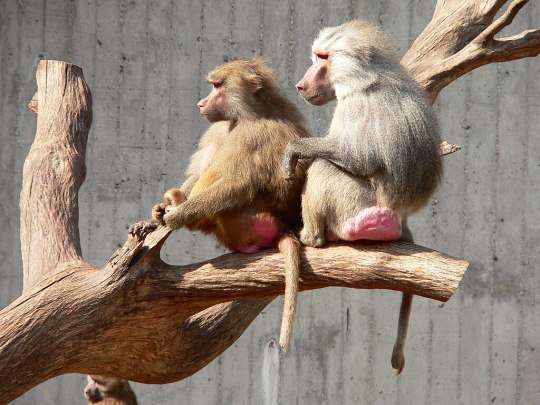

Primates. This order includes lemurs, monkeys, apes, and the girl reading this.
Dermoptera. This order is made up of the colugos, also known as ''flying lemurs''. They are able to glide up to 200 meters in distance.
#animals#biology#polls#poll tournament#zoology#lemurs#monkeys#apes#mammals#tetrapods#colugos#Primates#Dermoptera#0x40v0xbf#animal tournament#Animal Tournament Round 1
88 notes
·
View notes
Text

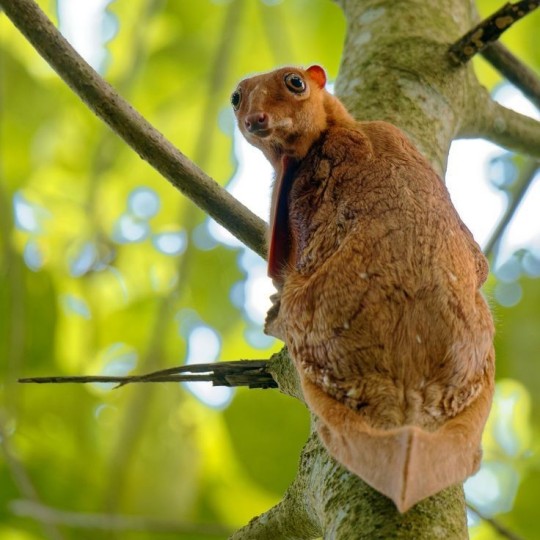

Sunda colugo/flying lemur - least concern
📍Southeast Asia
11 notes
·
View notes
Text

I think most people are aware of the fact that humans are related to other primates such as chimps, gorillas, mandrills and probably even Curious George. As a matter of fact, humans ARE primates, which means we share a common ancestor with all other primates. The order Primate includes many species other than just humans and animals that we usually call "monkeys", it also includes lemurs and some other minor families.
However, what I was curious to know was what animals are the most closely related to humans after the primates. To find out, we need to go up the ranks in our phylogenetic tree. As seen on the image on top, primates are part of the mirorder (like an order, but bigger) Primatomorpha, which includes the order Dermoptera (yes, Greek nerds, this means something along the lines of "wing skin"). The order Dermoptera consists entirely of colugos, which are also known as flying lemurs. Despite their name, they are not lemurs and despite their appearance, they are not flying squirrels. They just happen to also be equipped with a patagium (the skin membrane they use to glide) due to convergent evolution. While this is surely interesting, colugos are quite obscure animals and I was looking for a group of animals that would be more "commonly known", even if a bit less related to humans.
We can go even higher up in our phylogenetic tree and see that Primatomorpha are part of the grandorder (like a mirorder, but even bigger) Euarchonta and have a sister order, Scandentia. Animals in the order Scandentia are referred to as "tree shrews", but again, the name is misleading because while they are indeed arboreal, they are not shrews. The image above has one example of these creatures, a tupaia, and while they are cute and all, they are still not what I would call a "commonly known animal". Also, note that the position of the order Scandentia in the evolutionary tree is actually debatable as some researchers place them as a sister clade* to the Glires.
Going one more rank up in our phylogenetic tree, we see that Euarchonta are part of the superorder (like a grandorder, but bigger, you get the idea) Euarchontoglires, which includes the clade Glires. Within this clade are found the orders Lagomorpha and Rodentia, which are both comprised of very well known animals, such as rabbits and rats. I think it's pretty cool to think that those animals are quite closely related to primates, and therefore, to humans. Probably this is why they are (sadly) used for animal testing of medicine and cosmetics, although they are also probably used because of economical reasons.
* I will one day make a post about this word, it's actually pretty interesting.
#animals#primates#humans#colugo#order#clade#dermoptera#primatomorpha#scandentia#euarchonta#euarchontoglires#glires#phylogenetic tree#phylogeny
8 notes
·
View notes
Text
Black beauty caught masturbating at car wash
SEXY ebony teen masturbates with THICK toy while casting for PORN
Rica china
Levei a minha esposa para fazer sexo anal pela primeira vez com outro homem
حط على الموزه من الخلف كيفها احلى نيك شديد
Novia hotel sexo rico
Gorgeous and Sexy American Black Instagram Model with Perfect Body Enjoying Hot Sex with Her New British Follower with Very Big Cock and Gets Filled Up With Cum
Desi girl showing boob and pussy to her bf
Babe receives unfathomable doggy style while hot mum licks her anal
vintage french blowjob
#slubbing#Dermoptera#coitional#well-fermented#palaeotypographical#apostasy#Caporetto#counteroffensive#daminette#wappenschaw#fluffed#plasmodic#disinhuming#Axminster#floodways#equisonant#trophi#dauntlessly#myartstyle#steep-roofed
1 note
·
View note
Text
Kubung
Flying Lemur | Tupai dari Asia Tenggara | Kubung Sunda | Hewan Nokturnal | Kubung Malaya
Kubung, Merupakan hewan endemik indonesia berjenis tupai yang berasal dari Asia Tenggara yang termasuk kedalam ordo dermoptera. Nama Ilmiah dari hewan ini adalah Cynocephalus variegatus. Hewan ini merupakan hewan yang tidur pada siang hari dan bergerak pada malam hari atau disebut dengan hewan…
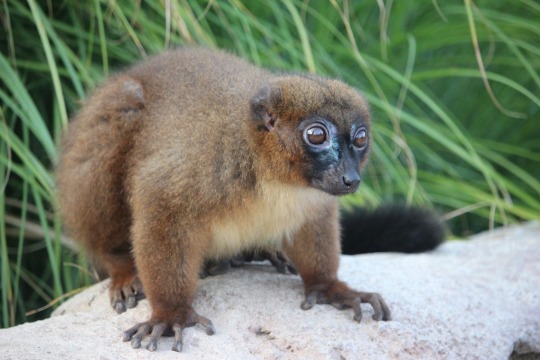
View On WordPress
#animal#camouflaged animal#colugo#dermoptera#flying lemur#good trend#herbivora#herbivorous#hewan dilindungi#hewan endemik#hewan nokturnal#indonesia#keep#kubung malaya#kubung sunda#mammal#morfologi#morphology#nocturnal#nocturnal animals#protected animal#squirrel#tend#wildlife
0 notes
Text
Leveraging my thousands of followers to cheat at tumblr polls: I love colugos but can you please go here and vote for primates? I can't have primates losing to a minor clade with only two species 😭
Do it for the aye aye!
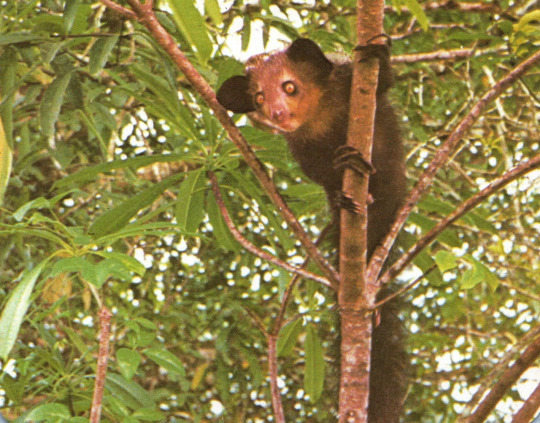

Do it for Pussi!



18 notes
·
View notes
Text
Anthro Allies Remastered (Part 4)
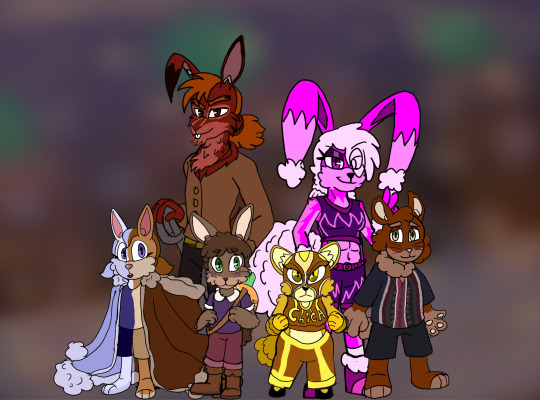
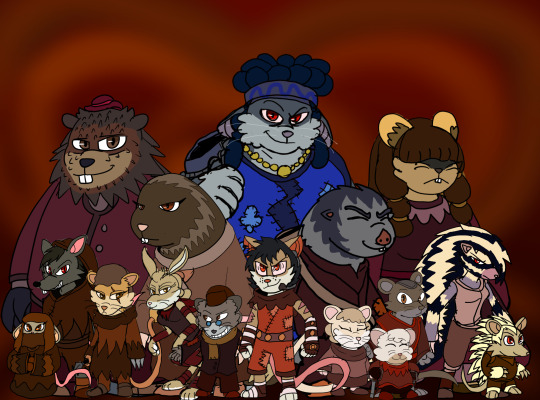

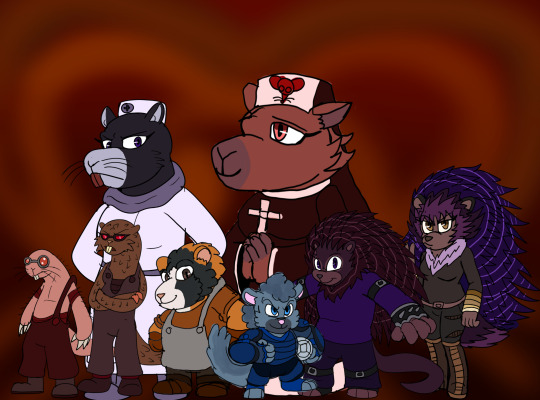

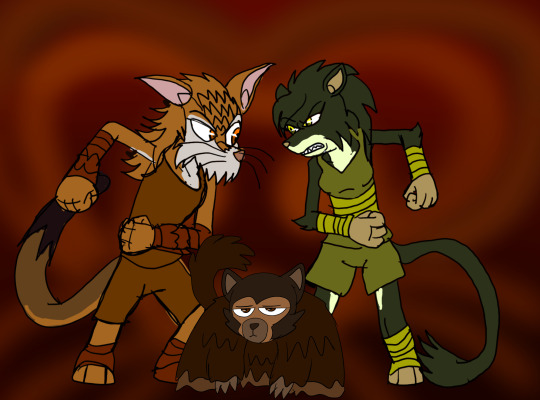
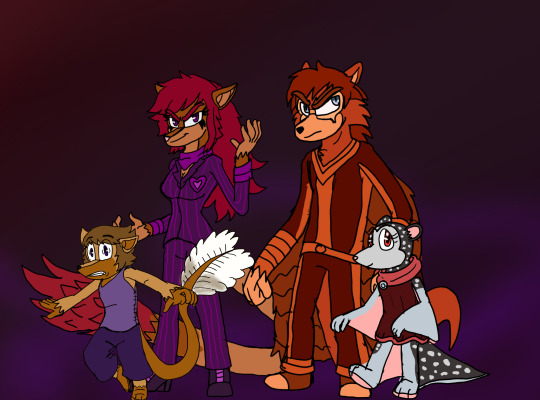
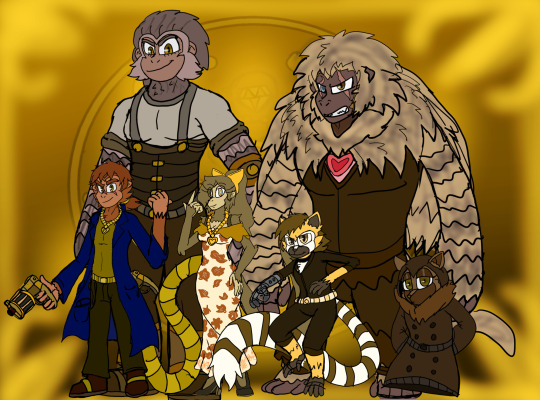

Part Two of the mammals
Lagomorphs
Sprint (Rabbit hybrid)
Gregory ( Continental Giant/Flemish Giant)
Eira (Snowshoe Hare)
Jack/Seac (Hare/ Jackrabbit)
Chica (Pika)
Ignatius (Volcano Rabbit)
Rodents
Zuke (Grasshopper Mouse), Peak (House/Field Mouse), Duke (Pack rat), Sneak (Black/Brown Rat), Poke (Spiny Mouse), Mesh (Maned Rat). Bound (Jerboa), Branch (Birch Mouse), Squeak (Mouse-Like Hamster), Cheeks (Hamster), Leap (Gerbil), Flirt (Vole), Ermentrude (Bamboo Rat/African Mole rat), Root (Zokor), Cliff (Lemming), Kastur (Muskrat)
Engi (Beaver), Kicks (Kangaroo rat), Go-4 (Gophers), Pouch ( Pocket mouse)
Rookie (Guinea Pig), Virtue (Capybara), Buster (New World Porcupine), Patricia/Thorn (Old World Porcupine), Cookie (Chinchilla), O.T. (Nutria), Bare (Naked Mole Rat), Dwojra (Blesmol Mole Rat)
Wrilly (Grey Squirrel), Maple (Red Squirrel), Danny (Chipmunks), Glide (Flying Squirrel), Philip (Marmot/Groundhog), Maisie (Prairie Dog), Areca (Palm Squirrel), Bling (Oriental Giant Squirrel), Nobby (Dormouse), Mount (Mountain beaver)
Fisk (Spring Hare), Screwy (Scaly tail), Twinge (Flying Mouse)
Scandentia
Felicity (Large Treeshrew)
Banxs (Pen Tailed Treeshrew)
Dermoptera
Galan (Philippine Colugo/Flying Lemur)
Flag (Sunda Colugo/Flying Lemur)
Primates
Anomy (Unspecified Monkey)
Ina (Unspecified Monkey) Belongs to @mabelcococups
Richie (Lemur)
Tara (Tarsier)
Manga (Old and New World Monkey)
Samosa (Ape)
Wicked (Human/Fae)
Forge (Human/ Shapeshifter)
Quilia (Human/Fire creature)
Xuitra (Human/Ice Creature)
Mystery (Mutant Human)
Historia (Mutant Human)
Mada/Adam (Clone Human)
Emey (Human)
Previous/Next
(For More Information About The Earthdemons, Neo demons, The Anthro allies , the O'Kong family and more of theses characters as well as updates please visit the @the-earthdemon-hub for more)
#my art#my ocs#aj the elementalgod#elementalgod aj#isle 0#toonverse oc#The Watchful Eye#Watchful Eye#O'Kong Family#Earthdemon#Neo Demons#Anthro Allies#Mammals
5 notes
·
View notes
Text

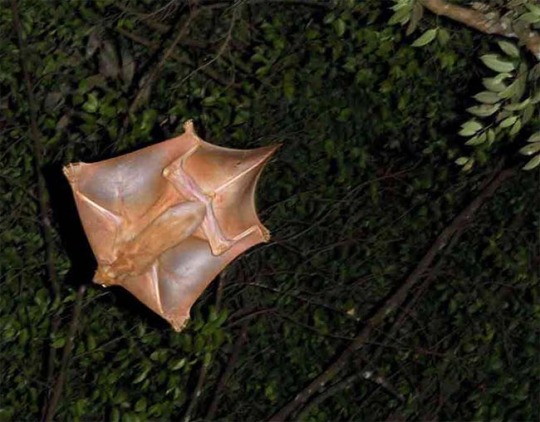

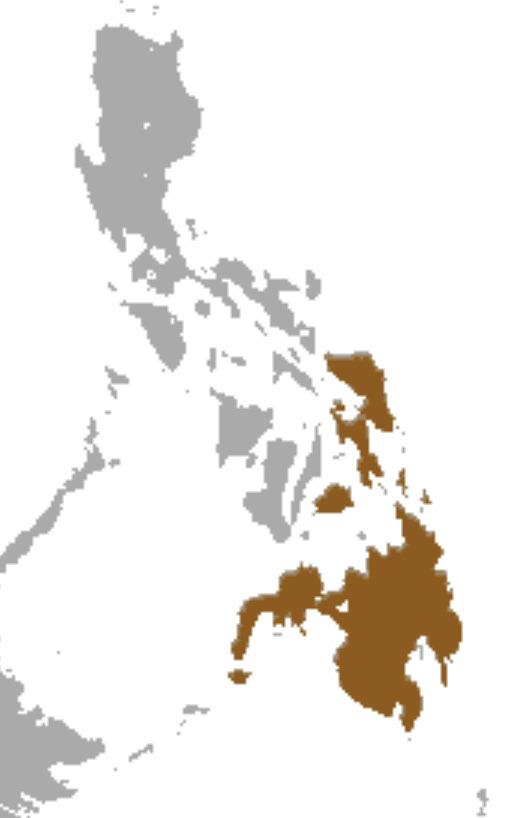
Philippine colugo
Cynocephalus volans
Family cynocephalidae, order dermoptera, mirorder primatomorpha
It’s the only one in its genus.
It is also known as the kagwang, and philippine flying lemur. It is not a lemur though, nor does it fly. It glides and is a close relative of primates. It isn’t a primate tho.
There are only two official members of its order. This guy, and the sunda colugo. There are two others that haven’t been formally classified: the bornean colugo and the javan colugo.
They stay up in the canopy or mid level of rainforests and rarely come to the ground. They’re kinda clumsy when climbing and have sharp claws and opposable thumbs.
They carry their babies with them using their skin like a pouch. Kind of like bats. They care for their young only until they’re weaned.
They are about 90% of the diet of the philippine eagle
@jackalspine @fifiibibii
3 notes
·
View notes
Text
human ears are so incredibly fail. one of our worst traits. this is why drawing humans with animal ears is so popular. anyway this problem is actually ancestral even before primates, look at these members of the sister clade to primates (scandentia, dermoptera)
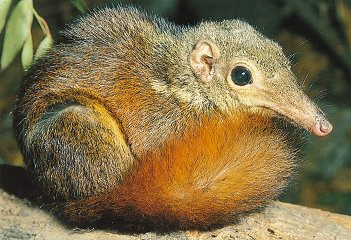
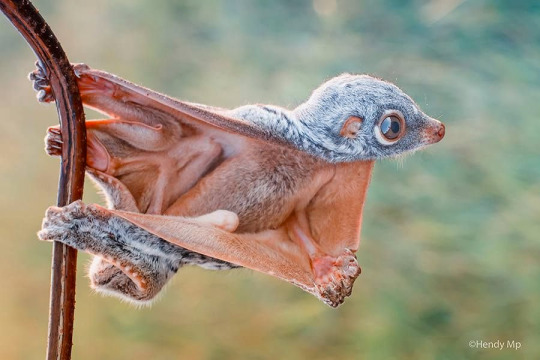
weird little flat ears. anyway next closest families are rodentia and lagomorpha which of course have cute ears
16 notes
·
View notes
Text
Working out the brain by going on a Wikipedia deep dive.
Anyway I would like to introduce you all to the Colugo!

There are two species of these guys, and they’re colloquially known as flying lemurs (despite being gliding mammals, and also not lemurs).
The two species, The Sunda Flying Lemur (The image above), and the Philippine Flying Lemur (the image below) , are the only members of their Family (Cynocephalidae) as well as their Order (Dermoptera).
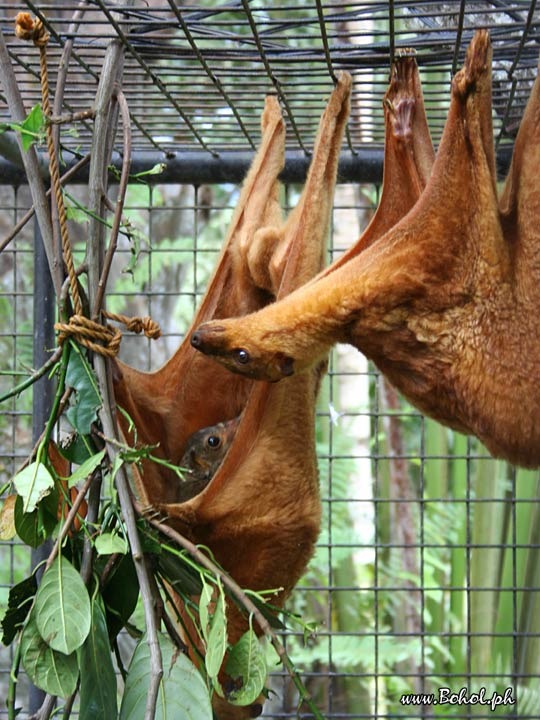
Sunda Colugos are found throughout Southeast Asia, in Malaysia, Sabah, Singapore, Indonesia, Bali, and many adjacent islands. The Philippine colugo on the other hand, is only found in the Philippines.
The closest mammals related to them are Primates, and colugos are the sister group of the ANCESTORS of Primates. These ancestors broke off into Plesiadapiformes (the extinct sister group of primates), and modern primates. So in untechnical terms, colugos are the aunt group of us primates!
Despite being placental mammals (mammals with nipples that aren’t marsupials), Colugos reproduce very similar to marsupials! They give birth to their young at a very early stage in development, then fold their long webbed tail into a pseudo pouch to Store their young in. These babies become mature at around 2 to 3 years old.
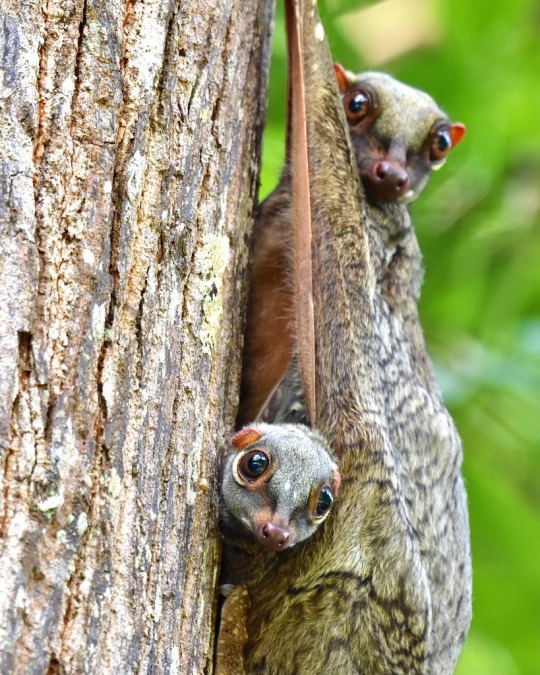
Colugos are arboreal, meaning they live in the trees, and their blanket like appearance is due to the webs of skin between their limbs and tail, which allows them to glide from tree to tree. Despite their fuzzy top side, their underbellies are completely hairless, which makes them appear like a naked man kite when gliding.

Colugos were classified as Vulnerable in 1996, but were reclassified as least concern in 2008. As tree living species, they are particularly vulnerable to deforestation, and their presence is important as they make up 90% of the diet of the endangered Philippine eagle.
Lastly. Baby colugo is his own hammock.

3 notes
·
View notes
Text
ok i love the fact that flying lemurs have the scientific classification of dermoptera. theyre literally called Flying Skin and its accurate bitch!!!!!
1 note
·
View note
Photo


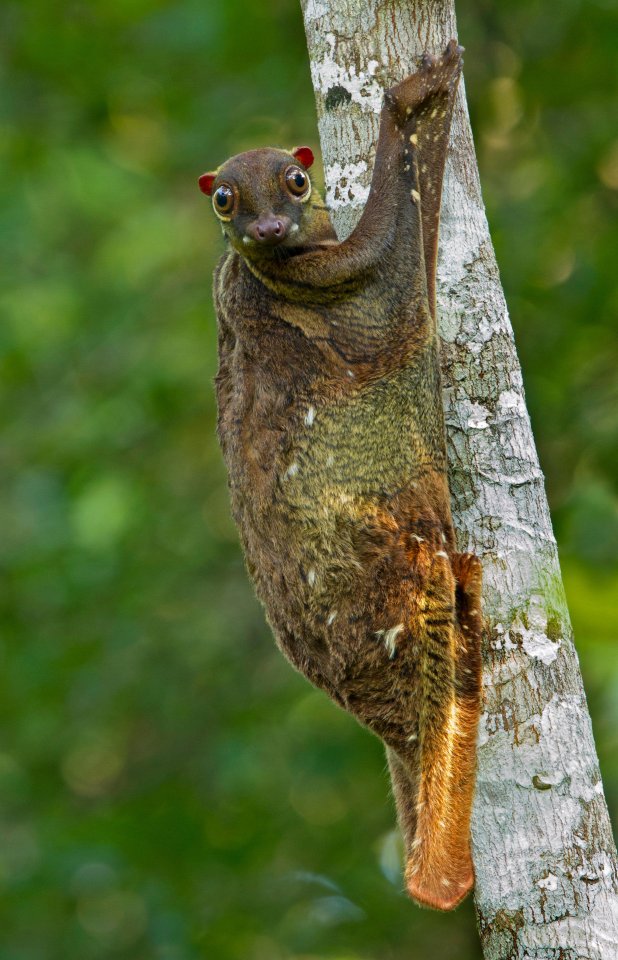
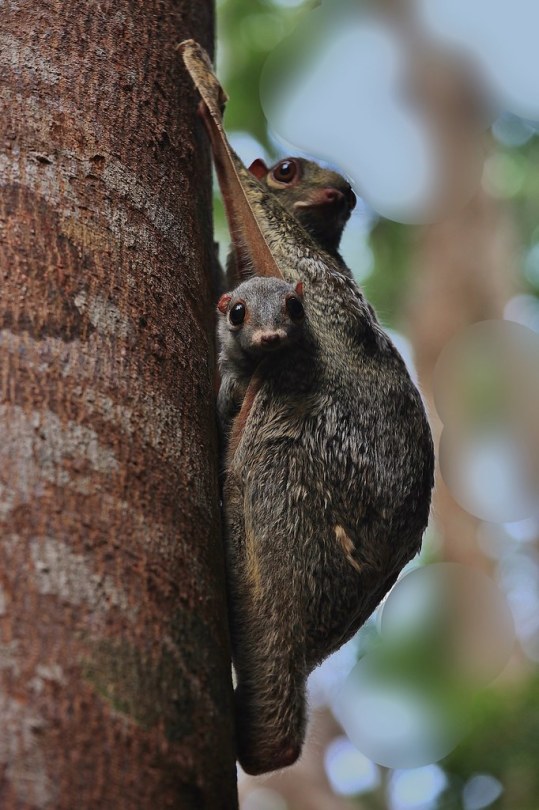
A Fantastic Sunda Flying Lemur
Somewhat misnamed, the Sunda flying lemur or Sunda colugo (Galeopterus variegatus) is a species of small, gliding mammal native to the tropical rainforests of southeast Asia. Galeopterus variegatus is not a lemur, but they are closely related to primates. They spend their entire lives in the canopy, and is actually fairly helpless on the ground. Like other gliding mammals, the Sunda colugo is specially adapted for its lifestyle: a thin membrane of skin called the patagium connects all four of their limbs and the tail, and allows them to move smoothly from one tree to another. The tail can also be converted into a pouch which the Sunda colugo can use to carry its young while climbing or gliding.
Sunda flying lemurs mate throughout the year, and after a short two month pregnancy, females give birth to just one baby. Male parental care is uncommon, although Sunda flying lemurs can live in loose groups within an area. Young are weaned after only six months, although they generally stay with their mother for up to three years. During that time, the mother may mate again, and females are able to nurse one baby while pregnant with another. Their lifespan is unknown, although some captive individuals were as old as seventeen when they died.
As with many lemur-like species, Sunda colugos are herbivorous. Fruit takes up a large part of their diet, although they also feed on flowers, buds, and sap. Their specialized, comb-shaped lower insicors are thought to have been developed to scrape sap from trees or flowers. They are also known to lick the bark of certain trees to obtain various nutrients and water. G. variegatus is mainly nocturnal; during the day they sleep in branches or holes of trees, and at night travel through the treetops to look for food and potential mates. They are exceptionally skilled gliders, capable of travelling over 100 meters without losing much elevation, and can use their tail and limbs to change direction or slow down.
Conservation status: Rated by the IUCN as least concern, although populations are declining. The Sunda flying lemur is able to adapt to disturbed forests, but habitat loss, competition with invasive species, and hunting all pose threats.
#sunda flying lemur#Dermoptera#Cynocephalidae#colugos#flying lemurs#mammals#tropical fauna#tropical mammals#tropical forests#tropical forest mammals#tropical rainforests#tropical rainforest mammals#islands#island mammals#southeast asia#animal facts#biology#zoology
133 notes
·
View notes
Text

Edinburgh Journal of Natural History and of the Physical Sciences, Vol. I (c. 1835-1839)
#Wonder Rooms#Cabinet of Curiosities#Public Domain#Edinburgh Journal of Natural History and of the Physical Sciences#19th Century#Scientific Illustration#Zoology#Animalia#Mammalia#Dermoptera#Cynocephalidae#Gliding mammals#Colugo#Flying Lemur
10 notes
·
View notes
Photo
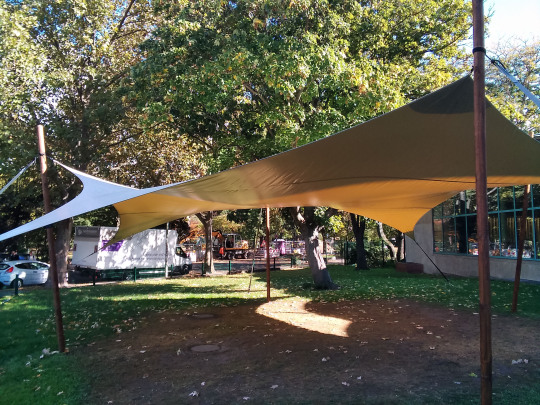
#u6#hallesches tor#zlb#amerika-gedenkbibliothek#mobile architekturen#emblematische narrationen in der figur des dj#jet#dermoptera#gerberstraße
2 notes
·
View notes
Photo

Sunda colugo (Galeopterus variegatus)
Photo by _husky_
#sunda colugo#sunda flying lemur#colugo#galeopterus variegatus#galeopterus#cynocephalidae#dermoptera#primatomorpha#euarchontoglires#boreoeutheria#eutheria#mammalia#tetrapoda#vertebrata#chordata
30 notes
·
View notes
Text
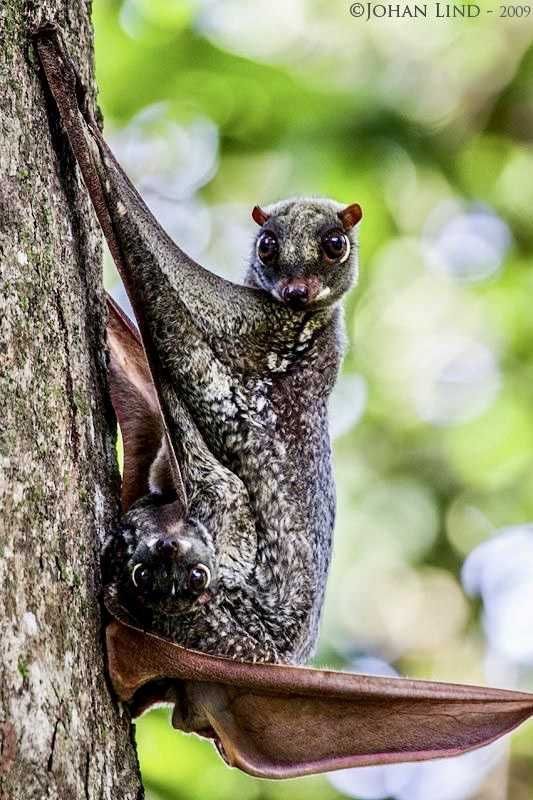
I’ve just discovered another animal I thought had to be fake. No. It’s real.
This is a colugo.
“arboreal gliding mammals that are native to Southeast Asia. Their closest evolutionary relatives are primates. There are just two living species of colugos: the Sunda flying lemur and the Philippine flying lemur. These two species make up the entire family Cynocephalidae and order Dermoptera.”
I knew flying squirrels and lemurs were a thing. I did not know there was a winged lemur.
Look at that face. Just look. What kind of a face is that?
72 notes
·
View notes